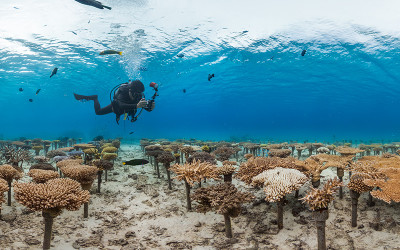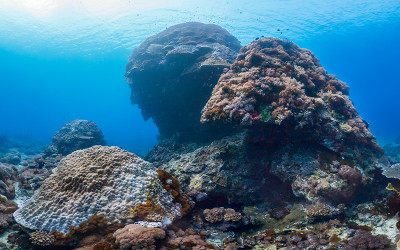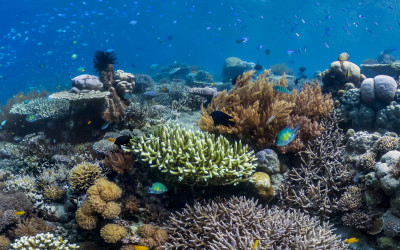Google Street View
amazing locations, great experiences, beautiful world
Yamada Point
This year I have been working on the coral reefs around Okinawa in Japan. These waters contain the oldest and largest reefs in the Northern Hemisphere. This area has experienced some of the most devastating effects of climate change which has accelerated coral bleaching. This coral plantation at Yamada Point was built by local fishermen and is now the largest man-made coral field at over 2.5 hectares. These images are a result of a collaboration between Panedia, Google, The Ocean Agency and the XL Catlin Seaview Survey. Although I don’t do the Photography I always enjoy working on these beautiful images.
Typhoon Toppled Coral
This is the “Big Mushroom” coral off the Taiwanese coast. It was considered one of the worlds most iconic dive sites. Despite surviving being struck twice by submarines this 1000 year old life form was finally toppled by Typhoon Meranti recently. You can still experience this 12 metre high coral structure in all its glory thanks to this virtual dive we published in June. These images are a result of a collaboration between Panedia, Google, The Ocean Agency and the XL Catlin Seaview Survey. Although I don’t do the Photography I always enjoy working on these beautiful images.
Raja Ampat
These are the waters around the Raja Ampat Islands in Indonesia. This area has the highest density of marine life in the world. The Great Barrier Reef in Australia is the largest coral reef system but it is relatively young compared to this one. The diversity of life here is helped by being uniquely placed between the Indian and Pacific oceans and three continental plates. These images are a result of a collaboration between Panedia, Google, The Ocean Agency and the XL Catlin Seaview Survey. This project takes up most of my working week, although I don’t do the Photography, I have a lot of fun working on these beautiful images in Photoshop.
Bare Island at Botany Bay, Sydney
Botany Bay was the site of Captain James Cook’s first landing of the HMS Endeavour on the continent of Australia in 1770. They called the site “Stingray Bay” originally as the area was so full of the creatures. Bare Island is found on the northern edge of Botany Bay – while you won’t find any stingrays on this virtual dive you might be able to spot a tiny, bright nudibranch. Can be seen here in Google Oceans.
Camp Cove, Sydney
Camp Cove is often the first place people learn to dive in Sydney. A gentle shore entry leads out into a rocky wall that is home to some of Sydney Harbour’s strangest marine creatures. See what you can find on this virtual dive. Can be seen here in Google Oceans.
Big Momma, American Samoa
Its true name is “Fale Bommie” (in honor of Fale Tuilagi who discovered it), but “Big Momma” is the nickname local divers have given this huge Porites coral, which may well be the largest coral on the planet. It is 41 metres in circumference and 7 metres high. This type of coral grows very slowly, as little as 1 centimetre a year, which means that this coral is over 500 years old! Big Momma is located in the aptly named “Valley of the Giants” within the National Marine Sanctuary of American Samoa. Image collect by Catlin Seaview Survey. Can be seen here in Google Oceans.
Humpback Whales in Rarotonga, Cook Islands
The whole 2 million square kilometre exclusive economic zone of the Cook Islands is a designated whale sanctuary. During May and October every year the Humpback Whales arrive in the Cook Islands. They are migrating north to South Pacific waters from their summer feeding grounds of Australia, New Zealand, and the cool Antarctic Ocean. They use these warmer waters to mate, give birth and to rest. Can be seen here in Google Oceans.
Loch Ness
Explore the surface and dive underwater in the freshwater lake of Loch Ness. Take in its haunting beauty, made darker still by the peat particles found in its waters, and let the rippling water, tricks of the light, and drifting logs bring the legend of Nessie to life. Another partnership project with Catlin Seaview Survey and Google Oceans. Can be seen here in Google Street View.
Diving in Brasil
Translating to “thirty kings”, Trinta Reis is another spectacular dive in Fernando de Noronha which combines volcanic rock flows and white sandy bottoms. The volcanic rock structures provide habitat and protection for schooling fish, turtles and rays. Can be seen here in Google Oceans.
Shelly Beach, Sydney
Shelley Beach is a protected marine area (part of Cabbage Tree Bay) which was declared a “No Take” Aquatic Reserve in 2002. Since being listed as a protected area local scuba divers and snorklers say they are seeing an increase in marine creatures here – a great observation. Image collect by Catlin Seaview Survey. Can be seen here in Google Oceans.
Manly’s Fairy Bower, Sydney
Manly is another famous Sydney beach (this one is on the northern side of the Harbour) with a great underwater environment. The Fairy Bower sits between Manly Beach and North Head, and it’s a great place to see Dusky Whaler sharks. Image collect Catlin Seaview Survey. Can be seen here in Google Oceans.
Magic Point at Maroubra, Sydney, Australia
The Grey Nurse Shark is the world’s most menacing yet harmless shark. Although they grow to be rather large and have rows and rows of razor sharp teeth they’re not considered dangerous to humans – they’re rather docile. They breed off the coast of Maroubra and provide a real thrill for scuba divers. Image collect by Catlin Seaview Survey. Can be seen here in Google Oceans.
Hawaii
In partnership with Catlin Seaview Survey we released another set of stunning underwater images from beautiful reefs in Hawaii coast. Can be seen here in Google Oceans
Aquarius Reef Base
The Florida International University manages the Aquarius Reefbase which is an underwater habitat used by marine biologists and astronauts for training and study purposes. In August 2014 the Catlin Seaview Survey team visited the Reefbase while surveying the reefs around the Florida Keys. Can be seen here in Google Oceans.
Vivid Sydney on Google Views
We just uploaded our Vivid Sydney Virtual Tour to Google Views. The constellation includes 31 panoramas of this great show of light in the main attractions and buildings of Sydney. We had previously published a constellation of Sydney Opera House images during this festival so we decided now to extend that with images of the rest of the city. Panedia Google Street View
Florida Keys
There are 3 “Christ of the Abyss” statues currently sitting beneath the surface of the sea, this “American Christ” is the third and most recent in the set of bronze statues. It’s located in the waters off Key Largo, Florida and was cast from the same mould as the original statue. Florida’s “Christ of the Abyss” weighs 260kg but is secured to 9 tonnes of concrete – it’s been here since 1965. Can be seen here in Google Oceans.
Japan Constellations on Google Views
We added 6 new constellations to Google Views on the theme Japan. With a total of 124 panoramas this virtual tour gives a good perspective over several Japan locations. Panedia Google Street View
Alcatraz, California
In this constellation from Alcatraz we decided for the first time to add some informational content to our usual photographic coverage. This adds a lot of interest to “The Rock” virtual tour since we to tell a bit of the history and stories behind the pictures.
Sydney Harbour Sharks
We surveyed the world-famous Sydney Harbour in March 2014 in partnership with the Sydney Institute of Marine Science. The waters around North Head are teeming with life. Check out the Port Jackson Sharks in the bright green weed in these panoramas. Can be seen here in Google Oceans.
Los Angeles, California
Los Angeles is well know by Hollywood movie sets, studios and of course, movie stars. On this constellation now posted on Google Views, we show a bit of the other side the second most populous city in the US, beyond the film industry tag. Panedia Google Street View
3+ Million Google Views
Today we reached 3+ million views on Google Views. Just a short time ago we added 25 Hoover Dam photo spheres, totaling now 1027 Panedia panoramas on Google Views. Can be seen here in Panedia Google Street View.
Sian Ka’an, Mexico
Sian Ka’an is a biosphere reserve which extends from the east coast of Mexico out into the Caribbean Sea. Home to some 80 recorded species of reef-building corals, the portion of the Mesoamerican Reef within the reserve is one of the most bio-diverse in Mexico. Jointly with neighbouring aquatic habitats it harbours more than 400 species of fish and a wealth of other marine life. For this reason it was named as a UNESCO World Heritage Site in 1987. Image collect by Catlin Seaview Survey. Available in Google Street View, can be seen here in Google Oceans.
Belize Barrier Reef Reserve
The largest barrier reef in the northern hemisphere, UNESCO added this site to the World Heritage in danger list in 2009. The system illustrates a classic example of reef types through fringing, barrier and atoll, and the regions seven sites provide a significant habitat for threatened species. This particular dive features Half Moon Cay, at the southern end of Lighthouse Reef Atoll. Image collect by our partners, Catlin Seaview Survey. Available in Google Street View, can be seen here in Google Oceans.
Komodo Indonesia
Komodo Island is home to the world’s largest lizards, the Komodo Dragon. The initial drive to protect the region of Komodo was to protect the “living dinosaur” that makes these arid islands home. In 1986 it was declared a UNESCO World Heritage Site and a Man and Biosphere Reserve that now encompasses all the biodiversity of the area, marine, terrestrial and cultural. Available in Google Street View, can be seen here in Google Oceans.
Tubbataha, Philippines Virtual Dive
Tubbataha Reefs Natural Park was added to the UNESCO World Heritage list in 1993, it lies in the middle of the Sulu Sea and is one of the Philippines’ oldest ecosystems. The region contains excellent examples of pristine reef with an incredibly high diversity of marine life. The area supports 374 species of corals, (that’s almost 90% of all coral species in the Philippines!). The area also supports 11 species of cetaceans, 11 species of sharks, and an estimated 479 species of fish. This image collect focuses on the North Atoll and was completed by the Catlin Seaview Survey. Available in Google Street View, can be seen here in Google Oceans.
Coombabah Mangroves, Gold Coast
Coombabah Lakelands Conservation Area is an exceptional park with a boardwalk through wetlands in between eucalypt forest and mangrove swamp. The area is ideal for short walks and popular for bird watching. This constellation, now on Google views, is literally a walk through that area with panos taken every few meters. Panedia Google Street View
Palmela, Portugal
We published on Google Views a few photos of a small town in Portugal: Palmela. Palmela hosted a panoramic photography conference and is a lovely town full of small labyrinth streets that make their way up to the big 10th century castle. The view there is astounding and stretches all the way around for several kilometers until the next towns and the river Sado. Panedia Google Street View
Central Park, NYC on Google Views
By opposition to the rush of the Big Apple, Central Park is the heaven for nature and quietude in New York. We decided to published a series of constellations on Google Views that cover the large area of the park in a total of 255 panoramas. We think that this can give you a good idea of the park by experiencing virtually a long walk through that beautiful place. Panedia Google Street View
Chelsea Waterside Park, NYC
Another constellation on New York. This time is the Chelsea Waterside Park with a total of 14 panoramas. Panedia Google Street View
Topsy Turvey Tour
Take a Topsy Turvey Tour courtesy of a glitch in the Google Matrix. While working on some Google Views content this afternoon I noticed that Google had finally decided Australia was indeed the ‘Land Downunder’ and therefore it should see Google Maps Views upside down. I first noticed this on our Sydney Opera House Virtual Tours, but upon checking virtual tours we’d produced in New York they were also upside down. So perhaps it wasn’t Australia that was being flipped… it was any content produced by an Australian 😉 After messing around for a while I figured out how to make the tour flip upside down, and flip back the other way… so proceeded to have some fun… and make myself feel a little queasy at the same time. I suspect it won’t be around for long so I created a quick video for posterity. Here’s some of the links from the video above in case you want to try it yourself. (Note: I doubt this will work for very long. Chrome/Windows7) Google Maps Tour Links: Sydney Opera House Brooklyn Bridge – New York Uluru (Ayers Rock) Albuquerque Balloon Fiesta
Brooklyn Bridge, NYC on Google Views
We published another constellation on Google Views. This set is about a great evening with great friends. We walked Brooklyn Bridge altogether from Manhattan to Brooklyn by sunset. The views were astounding. But the best was yet to come: the perfect rainbow dusk colors in New York Skyline. Enjoy! Panedia Google Street View
Monaco Larvotto Marine Reserve
Larvotto Marine Reserve is a protected area in the Mediterranean Sea just off the coast of Monaco. Imagery collect from October 2013 by Catlin Seaview Survey in partnership with Oceanographic Museum of Monaco and Prince Albert II Foundation. The tour was also uploaded to Google Street View, and can be seen here in Google Oceans.
Monaco Museum
In October 2013 our Catlin Seaview Survey partners were invited by the Oceanographic Museum of Monaco to help them reveal the 2km of coastline that the Mediterranean Sea touches the principality of Monaco. It was our first temperate (cooler) water collect and this image shows just how clear the Sea is which is remarkable considering the traffic in the Med! The tour was also uploaded to Google Street View, and can be seen here in Google Oceanss.























